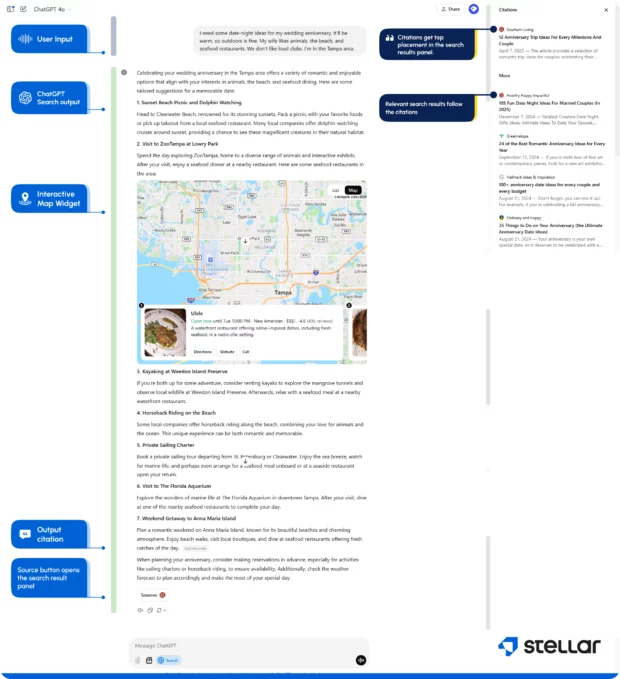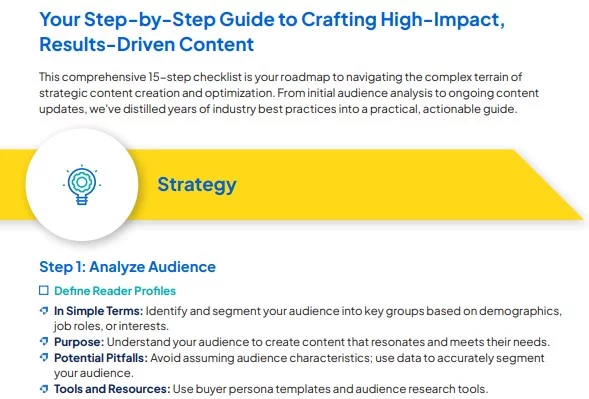
Let’s play a game. Spot the difference between these two search queries:
Query 1: Content writing services.
Query 2: We have a special content project coming up, and my in-house writers won’t be able to handle the volume. I need a content provider experienced with agencies, tight deadlines, and demanding clients. I don’t want to manage freelancers. I need a hands-off solution that ensures strong quality, adheres to content briefs, and includes image sourcing. Which companies would you recommend?
Give up? Here’s a hint: This shift in search behavior could revolutionize your content optimization strategies in 2025 and beyond.
What is generative engine optimization?
Generative Engine Optimization (GEO) is the strategy for ensuring your content is visible to AI-driven search engines, such as OpenAI’s ChatGPT Search. That’s it — it’s like SEO, but for AI search.
Is generative engine optimization important?
I recently spoke with Travis Tallent, Managing Director of Site Experience (SEO & CRO) at Brainlabs, about whether AI search is a real threat to Google and traditional search. He said, “The pie of searches and information gathering will expand. That is, Google won’t see less searches, but other search engines will see more as people start to turn to specific platforms for specific queries and tasks.”
And he’s right. AI search isn’t replacing Google — it’s expanding the way people search. Millions of queries that would not have been searches a year ago are now happening on AI platforms such as ChatGPT Search. This isn’t a future opportunity — it’s already happening, it’s growing fast, and marketers who move now will reap the rewards while everyone else plays catch-up.
If you’re serious about your content appearing in AI search, there are two crucial things you need to know:
- The method for selecting pages for citations and search results fundamentally differs from traditional search algorithms.
- The way searchers frame their queries is completely changing. Context matters, and your content needs to reflect that.
How does ChatGPT Search work?
ChatGPT Search works within the ChatGPT platform when the user clicks a small icon in the input field.

With the release of ChatGPT Search by OpenAI in October 2024, the system divides user inputs into multiple queries and then runs them through a third-party search index — primarily Bing. It then uses relevant content from those queries, along with ChatGPT’s core training, to generate an output customized to the unique scenario described by the user.
Detailed Breakdown:
- Citations Provided: This answer includes citations — links to pages that support the information provided.
- Multimedia Content: The output may also contain images and videos.
- Source Accessibility: A “source” button located at the bottom of the page opens a panel on the right side that displays the search results.
- Citation Organization:
- Top Section: Pages chosen as citations, clearly separated and labeled.
- Following Section: Pages deemed relevant to your search.

What about Google’s AI overview?
For the purpose of this article, we’re going to talk mostly about ChatGPT Search. We won’t spend much time on Google’s AI overview because it’s not the same thing. Yes, there are strategies for optimization, but they are similar to those used for any other Google search feature.
For the most part, Google’s AI overview shows a correlation between the AI output and top-ranking articles, with little change observed in user search behavior (short queries).
That said, on December 4th, 2024, Sundar Pichai, the CEO of Google, said the company’s search engine will “change profoundly” in 2025. He added, “I think you’ll be surprised, even early in ‘25, the kind of newer things search can do compared to where it is today.”
I have to think he’s referring to the next evolution of AI overview and Google’s response to OpenAI’s ChatGPT Search. But until we see that, we’ll stick with what’s happening right now.
So, how do you prepare for this shift in search behavior and ensure your content stands out in AI-driven searches? Use these six tips to get started.
6 tips to optimize your content for ChatGPT Search
These tips are a combination of our own research and lessons learned from others, but they come with two caveats:
- This is what appears to be working now. OpenAI is undoubtedly analyzing data and planning updates to its algorithm that may impact these tactics, for better or worse (particularly the one about dates in titles – I wouldn’t expect that to work for too long).
- There is no magic formula that’ll keep you from having to create exceptional content written specifically for your audience. Everything that helps you optimize for traditional search engines still applies.
Follow these tips to optimize your content for AI search:
1. Index your site with Bing
You may not be worried about your Bing rankings, but you must get indexed by Bing to appear in ChatGPT Search. To ensure this, check that your robots.txt file permits Bingbot and submit your site through Bing Webmaster Tools. While Bing can find your site organically, verification speeds up the process and provides you access to tools for monitoring performance and fixing issues.
To ensure Bing indexes your site, check out these step-by-step instructions that cover everything from verifying your site to submitting a sitemap.
2. Emphasize recency
Right now, there’s a clear preference for in-your-face recency. Run some quick searches and you’ll find no shortage of titles that have 2024 or 2025 in them. This will likely change as ChatGPT Search improves, but for now, it’s smart to make the recency of your content unmistakable, as long as it doesn’t detract from its readability and provides value to your audience.
Take this article, for instance. It references the year multiple times — with relevant information — and will likely need updates within months, especially after Google’s anticipated changes in early 2025. Evergreen content has its place, but don’t avoid emphasizing recency just to sidestep updates a few months down the line, especially for topics that evolve quickly.
One tip, though. Avoid putting the date in your URL slug as you won’t be able to change that without creating a new page.
Like several things on this list, this is an easy add to your content refresh/update list.
3. Look for unique and useful data
Data — especially unique, original data — is gold for traditional SEO, and GEO is no different. But to use data effectively as an optimization tactic, you need more than just numbers. Consider the searcher’s situation and include the context that makes the data relevant.
For example, our audience might wonder about the ideal word count for long-form content. While we know content should be as long as necessary to deliver value, satisfy search intent, and thoroughly cover the topic, the question still comes up.
A quick analysis of 10,000 long-form articles (500+ words) written on the Stellar platform in 2024 shows an average of 1,028 words. That’s real-world, original data that could find its way into an AI output someday.
4. Optimize for scenarios and situations
This is why the shift in user search behavior is so important. In traditional search engines, we don’t type out entire situations — we use the fewest words we think will get us the results we need.
But ChatGPT Search customizes its answers to unique scenarios. People naturally include context in their queries, and you want to optimize for that context. Often, searchers don’t know the solution they need — they only know the situation they’re struggling with.
Context optimization is like long-tail keywords on steroids. Optimizing your content ensures it aligns with how people frame their questions in AI search, increasing the likelihood that search engines will cite it. Consider the situations where your product or service is the perfect fit, and describe them in your content and on your site.
For example, imagine a scenario where your SaaS product enhances project management tools like Asana by adjusting task deadlines whenever team members miss due dates. A frustrated user might turn to AI search, describing their problem as follows: “My team keeps missing deadlines, and now my project timeline is completely off track. I need something to help keep everything on schedule, but I’m not sure what to use.”
Instead of just listing a feature like “automated deadline adjustment,” your content should reflect the scenario: “You’re stuck in a cycle where missed deadlines derail subsequent deadlines and throw your entire project off track. Our tool identifies delays, reschedules dependent tasks, and keeps your projects on track automatically.”
By addressing the user’s pain point and describing the solution in their terms, your content is more likely to resonate with the query and appear in AI-generated results.
You can even get this into your content briefs to guide your writers. Or, if you’re writing on the fly, taking a few minutes to think through user scenarios can make all the difference.
Just like the SaaS example above, these are the types of situations I considered as I wrote this article:
- You’re curious and want to learn more about AI search.
- Your clients have started buzzing about GEO, and you want to be ready to advise them on how to optimize their sites effectively.
- You’re currently updating a pile of articles, and you worry that you might need to do it again.
- You see an opportunity for your site or your clients’ content and want to take advantage.
- You want to know if AI search will truly impact how people ask questions and get answers.
- You carefully wrote your content for search optimization, and now you’re wondering if that means you’ll perform well in ChatGPT Search.
5. Create and get your service in listicles
Get your product or service to feature in as many authoritative lists as possible, and publish lists on topics where you’re an authority.
A recent study found that authoritative-list mentions weigh significantly more (at least 2:1) than other factors such as online reviews, awards, or social sentiment when generative AI chatbots choose products and services for outputs.
Listicles are easy for LLMs to digest and understand — just like they’re easy for humans to read, which is why they’re such a popular format. Having listicles increases your chances of appearing in AI-generated outputs, and publishing your own lists can drive traffic from accompanying search results.
Be mindful of lists when you’re updating your content. The refresh process can easily convert many standard format articles to include lists.
6. Follow SEO best practices
I won’t write long sections covering all the things you should already be doing for traditional SEO (and because it’s the right thing to do for your audience), so we’ll lump that all together right here.
If you’re already running a tight ship with SEO best practices, you’re already in pretty good shape for AI search.
- Create helpful, audience-focused content that satisfies search intent.
- Follow EEAT principles to build authority and trust.
- Include internal and external links to relevant sources.
- Optimize technical SEO, core web vitals, and schema markup.
- Use visuals like images and videos to enhance engagement.
- Promote content on social media and industry directories.
- Publish and encourage user reviews on platforms like G2 and TrustPilot.
- Join discussions on Quora, Reddit, and similar forums.
If your content needs work, check out our complete content production checklist to get it on the right track.

Trends change – GEO will too
Expect rapid and frequent change as major players like OpenAI, Google, and Microsoft launch and refine their platforms. New trends will emerge, and strategies that once worked will become obsolete.
Stay agile, monitor results, and adapt as the landscape evolves. If there’s one thing you can count on, it’s that exceptional content written to provide value to your audience is the foundation. Everything else is subject to change.
